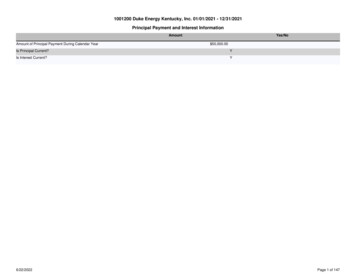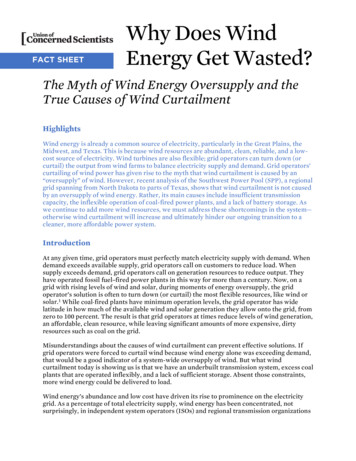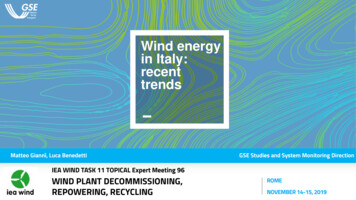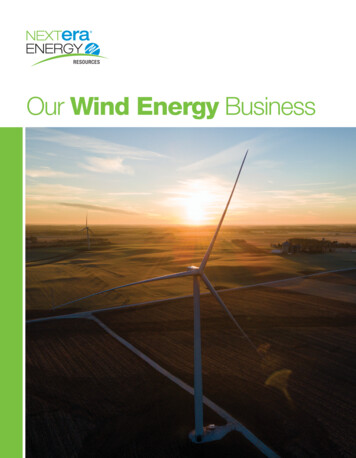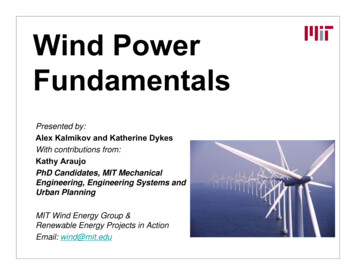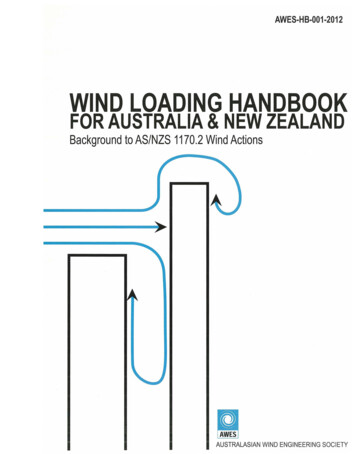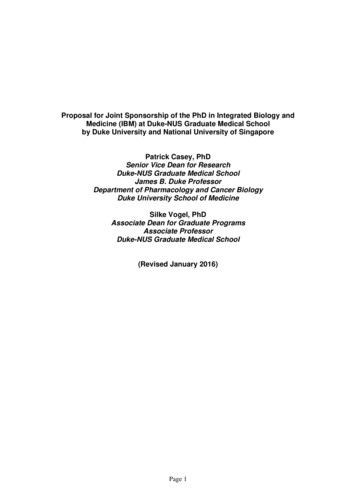
Transcription
WIND ENERGY SYSTEMSElectronic EditionbyGary L. JohnsonManhattan, KS
iTABLE OF CONTENTS1 Introduction.1-11.1 Historical Uses of Wind.1-21.2 History of Wind Electric Generation.1-31.3 Horizontal Axis Wind Turbine Research.1-51.4 Darrieus Wind Turbines.1-131.5 Innovative Wind Turbines.1-161.6 California Wind farms.1-212 Wind Characteristics.2-12.1 Meteorology of Wind.2-12.2 World Distribution of Wind.2-72.3 Wind Speed Distribution in the United States.2-82.4 Atmospheric Stability.2-142.5 Wind Speed Variation With Height.2-232.6 Wind Speed Statistics.2-262.7 Weibull Statistics.2-302.8 Determining the Weibull Parameters.2-382.9 Rayleigh and Normal Distributions.2-442.10 Distribution of Extreme Winds.2-552.11 Problems.2-623 Wind Measurements.3-13.1 Eolian Features.3-13.2 Biological Indicators.3-23.3 Rotational Anemometers.3-53.4 Other Anemometers.3-143.5 Wind Direction.3-173.6 Wind Measurements with Balloons.3-283.7 Problems.3-34Wind Energy Systems by Dr. Gary L. JohnsonOctober 10, 2006
ii4 Wind Turbine Power, Energy, and Torque.4-14.1 Power Output from an Ideal Turbine.4-14.2 Aerodynamics.4-44.3 Power Output from Practical Turbines.4-74.4 Transmission and Generator Efficiencies.4-134.5 Energy Production and Capacity Factor.4-214.6 Torque at Constant Speeds.4-294.7 Drive Train Oscillations.4-334.8 Starting a Darrieus Turbine.4-394.9 Turbine Shaft Power and Torque at Variable Speeds.4-434.10 Problems.4-495 Wind Turbine on the Electrical Network.5-15.1 Methods of Generating Synchronous Power.5-15.2 AC Circuits.5-45.3 The Synchronous Generator.5-145.4 Per Unit Calculations.5-225.5 The Induction Machine.5-275.6 Motor Starting.5-375.7 Capacity Credit.5-405.8 Features of the Electrical Network.5-485.9 Problems.5-586 Asynchronous Electrical Generators.6-16.1 Asynchronous Systems.6-26.2 DC Shunt Generator with Battery Load.6-56.3 Permanent Magnet Generators.6-116.4 AC Generators.6-186.5 Self-Excitation of the Induction Generator.6-206.6 Single-Phase Operation of the Induction Generator.6-32Wind Energy Systems by Dr. Gary L. JohnsonOctober 10, 2006
iii6.7 Field Modulated Generator.6-376.8 Roesel Generator.6-396.9 Problems.6-427 Asynchronous Loads.7-17.1 Piston Water Pumps.7-27.2 Centrifugal Pumps.7-107.3 Paddle Wheel Water Heaters.7-217.4 Batteries.7-237.5 Hydrogen Economy.7-337.6 Electrolysis Cells.7-407.7 Problems.7-478 Economics of Wind Systems.8-18.1 Capital Costs.8-18.2 Economic Concepts.8-98.3 Revenue Requirements.8-158.4 Value of Wind Generated Electricity.8-208.5 Hidden Costs in Industrialized Nations.8-238.6 Economic Factors in Developing Countries.8-248.7 Problems.8-269 Wind Power Plants.9-19.1 Turbine Placement.9-19.2 Site Preparation.9-29.3 Electrical Network.9-49.4 Selection of Sizes, Low Voltage Equipment.9-79.5 Selection of Sizes, Distribution Voltage Equipment.9-149.6 Voltage Drop.9-229.7 Losses.9-249.8 Protective Relays.9-28Wind Energy Systems by Dr. Gary L. JohnsonOctober 10, 2006
iv9.9 Wind farm Costs.9-309.10 Problems.9-34Appendix A: Conversion Factors.9-36Appendix B: Answers To Selected Problems.9-37Appendix C: Wire Sizes.9-39Appendix D: Streams and Waterways.9-4510 Kansas Wind Data.10-111 Comments on Wind Development.11-112 Kansas County Topographical Maps.12-1PREFACE TO FIRST EDITIONWind energy systems draw on a wide range of disciplines. Any prospective user, regardlessof his background, will feel large gaps in his knowledge, areas where he does not even knowwhat the question is, let alone where to go look for the answer. This book is written to helppeople identify the proper question to ask.There are several groups of potential users of a book on wind energy systems. There arethose with non technical backgrounds who want a readable introduction. There are graduateengineers who need a detailed treatment of some aspect of wind power systems. And there areundergraduate engineering students who need a formal course in the subject. We have chosenthe undergraduate engineering student as the primary audience, but have tried to considerthe needs of other users. Many of the key concepts should be readily understood by thosewith a good high school education. Those sections which demand a more technical treatment,however, assume a background in chemistry, physics, calculus, circuit theory, and dynamics.Rather detailed treatments of meteorology, statistics, electrical machines, and engineeringeconomics are given, but since these subjects are not studied by all engineers, no backgroundis assumed for these areas. Enough detail is included so that a technically trained personcan evaluate a given system for a proposed application and also learn enough of the specificlanguage that he can look elsewhere for more information in an efficient manner.This book will be of interest to those students who are interested in energy sources besidescoal and nuclear. Oil and natural gas are obviously not suitable long term solutions toour energy requirements, and coal and nuclear energy face severe environmental obstacles.This means that the so-called alternative energy sources may well become primary sourcesover the next few decades. At the present time wind, solar photovoltaic, and solar thermalsystems appear to be the main contenders for supplying a substantial fraction of the energyrequirements of the United States and much of the remainder of the world as well.Wind Energy Systems by Dr. Gary L. JohnsonOctober 10, 2006
vA number of books about wind power have been written in the last decade by thoseworking in the field. These books generally have no problems at the end of the chapters, andhence are difficult to use in a formal course. The author believes that significant numbers ofstudents in engineering or technology would be interested in a course on wind energy systemsif an appropriate textbook were available. It is hoped that this book will fill such a need.An attempt has been made to pull together information from many sources and presentit in a clear, consistent fashion in this text. Most of the material is available in the openliterature, but some that has been developed from research at Kansas State University hasnot been published elsewhere. This includes some wind speed data and much of the materialon induction generators.Both large and small wind turbines are discussed. The person designing a wind farm ofmulti-megawatt machines connected to the utility grid should find the necessary backgroundmaterial here, as well as the person desiring to install a small battery charging system ina remote location. Information is included on piston pumps, centrifugal pumps, batteries,electrolysis cells, and other topics that may be important in certain wind power applications.Much of this information is difficult to find in a concise form elsewhere, so this should increasethe usefulness of the book.The field is evolving rapidly, so some specific examples will become obsolete quickly. Aneffort has been made, however, to present the basic information that is not likely to change,so the book will be useful for a number of years.It has been the author’s experience that the quantity of material is ample for a threehour course. The instructor may need to be selective about sections to be covered. Chapters2,4,5, and 8 are viewed as the heart of the course, and the other chapters can be omitted, ifnecessary, with little loss of continuity. The book has been classroom tested over a five yearperiod and much of it has been rewritten to include improvements suggested by the students.SI units have been used extensively throughout the book, with English units used asnecessary to bridge the gap between present practice and the anticipated total conversion toSI units. A list of conversion factors is given at the end of the book.A good selection of problems is given at the end of each chapter. Some problems requirethe use of a programmable hand calculator or a digital computer. These can be used whereall the students have access to such equipment to give additional practice in computationaltechniques.The author wishes to express appreciation to Theresa Shipley and Teresa Gallup for typingvarious versions of the manuscript. He also wishes to thank the many students who offeredsuggestions and criticisms. Finally, he wishes to thank his wife Jolene, and his children, Kirkand Janel, for their patience during the writing of the book.Wind Energy Systems by Dr. Gary L. JohnsonOctober 10, 2006
viPREFACE TO SECOND EDITIONA ninth chapter, on wind farm layout, has been added to the second edition. This discussestopics like wire and transformer selection. We actually start the semester with this chapterand Chapter 8, so we can give a wind farm design project early in the semester. Each studentis asked to do a paper design of a wind farm, including layout, sizing of components, andeconomic analysis. This design has worked very well, helping to make the course one of themost popular elective courses in the department. There were 46 in the course Fall 1993, whichwas the largest enrollment of any elective course in the department. The chapter has enoughtables on wire sizes, wire costs, transformer sizes and costs, and other costs that the studentcan feel confident of doing a respectable design without seeking other sources of information.Each student is given a topographical map and an aerial photo of a particular square mileat one of five sites, and performance data for a particular turbine or two at that site. Onestudent may have a flat site while another may have one with hills and sharp ravines. Somesites have railroads or pipelines. Each student has a different design to do, which greatlyreduces concern about copying, but still the difficulty of each design is approximately thesame. The deadline for designs is about two-thirds of the way through the semester, so thereis ample time to grade them.Once the designs are given, we go back to the start of the book and see how far we canget. We usually skip Chapter 3, and the portions of Chapter 5 that are covered in an earlierrequired course on Energy Conversion.After Prentice-Hall let the First Edition go out of print, the copyright was returned tothe author. This Second Edition is copyrighted, however, it is planned to grant a broadauthorization to copy and/or edit any or all of this material to a school or other organizationupon the payment of a one time fee. Any reader who is not already covered by an existingauthorization should contact the author for details.Gary L. JohnsonManhattan, KSJanuary 1994PREFACE TO ELECTRONIC EDITIONThe author took early retirement in May, 1994 and spent the next two years working as aconsultant to a wind farm developer that was interested in establishing a wind farm in Kansas.A large ranch in southern Kansas was selected and three towers were instrumented, two at 40m and one at 60 m. At the end of two years it was obvious that it would be several more yearsWind Energy Systems by Dr. Gary L. JohnsonOctober 10, 2006
viibefore wind farms were established in Kansas, so the developer walked away from the lease.The rancher and the author continued to collect data until another developer was found tolease and develop the site. The 150 MW Elk River Windfarm is now producing power at thissite.A number of copies of this book were photocopied and sold since 1994, and several organizations opted to buy the permission to edit and photocopy at will, as mentioned in theprevious preface. But things have slowed down such that economically there is no point incontinuing this process. While some of the prices are outdated, the author believes there isconsiderable basic information in this book that is still quite valid. Therefore the decision wasmade to scan in some of the figures and photographs and prepare these files in PDF format.The only change made was to put references at the end of each chapter rather than at theend of the book. Except for the photographs copyrighted by others, this material should beconsidered as in the public domain. May it yet serve a role in establishing wind power as asignificant source of electrical energy throughout the world.November, 2001October, 2006Wind Energy Systems by Dr. Gary L. JohnsonOctober 10, 2006
Chapter 1—Introduction1–1INTRODUCTIONLook at the ships also:, though they are so great and are driven by strong winds, they areguided by a very small rudder wherever the will of the pilot directs. James 3:4The wind is a free, clean, and inexhaustible energy source. It has served mankind wellfor many centuries by propelling ships and driving wind turbines to grind grain and pumpwater. Interest in wind power lagged, however, when cheap and plentiful petroleum productsbecame available after World War II. The high capital costs and the uncertainty of the windplaced wind power at an economic disadvantage. Then in 1973, the Arab nations placed anembargo on petroleum. The days of cheap and plentiful petroleum were drawing to an end.People began to realize that the world’s oil supplies would not last forever and that remainingsupplies should be conserved for the petrochemical industry. The use of oil as a boiler fuel,for example, would have to be eliminated. Other energy sources besides oil and natural gasmust be developed.The two energy sources besides petroleum which have been assumed able to supply thelong term energy needs of the United States are coal and nuclear energy. Many people thinkthere is enough coal for several centuries at present rates of consumption, and likewise fornuclear energy after the breeder reactor is fully developed. These are proven resources in thesense that the technology is highly developed, and large coal and nuclear powered electricalgenerating plants are in operation and are delivering substantial blocks of energy to theconsumer. Unfortunately, both coal and nuclear present serious environmental problems.Coal requires large scale mining operations, leaving land that is difficult or impossible torestore to usefulness in many cases. The combustion of coal may upset the planet’s heatbalance. The production of carbon dioxide and sulfur dioxide may affect the atmosphere andthe ability of the planet to produce food for its people. Coal is also a valuable petrochemicalfeedstock and many consider the burning of it as a boiler fuel to be foolish.Nuclear energy has several advantages over coal in that no carbon dioxide or sulfur dioxideare produced, mining operations are smaller scale, and it has no other major use besidessupplying heat. The major difficulty is the problem of waste disposal, which, because of thefears of many, will probably never have a truly satisfying solution.Because of these problems, wind power and other forms of solar power are being stronglyencouraged. Wind power may become a major source of energy in spite of slightly higher coststhan coal or nuclear power because of the basically non-economic or political problems of coaland nuclear power. This is not to say that wind power will always be more expensive thancoal or nuclear power, because considerable progress is being made in making wind power lessexpensive. But even without a clear cost advantage, wind power may become truly importantin the world energy picture.Wind Energy Systems by Dr. Gary L. JohnsonOctober 10, 2006
Chapter 1—Introduction11–2HISTORICAL USES OF WINDThe wind has been used to power sailing ships for many centuries. Many countries owedtheir prosperity to their skill in sailing. The New World was explored by wind powered ships.Indeed, wind was almost the only source of power for ships until Watt invented the steamengine in the 18th Century.On land, wind turbines date back many centuries. It has been reported that the Babylonianemperor Hammurabi planned to use wind turbines for irrigation in the seventeenth centuryB.C. [3]. Hero of Alexandria, who lived in the third century B.C., described a simple horizontalaxis wind turbine with four sails which was used to blow an organ [3].The Persians were using wind turbines extensively by the middle of the seventh centuryA.D. Theirs was a vertical axis machine with a number of radially-mounted sails [3].These early machines were undoubtedly crude and mechanically inefficient, but they servedtheir purpose well for many centuries. They were made from local materials by cheap labor.Maintenance was probably a problem which served to keep many people at work. Their sizewas probably determined by the materials available. A need for more power was met bybuilding more wind turbines rather than larger ones. There are many of the lesser developedcountries of the world today which could profitably use such low technology machines becauseof the large amounts of cheap, unskilled labor available. Such countries often have difficultyacquiring the foreign exchange necessary to purchase high technology machines, and then havedifficulty maintaining them.The earliest recorded English wind turbine is dated at 1191. The first corn-grinding windturbine was built in Holland in 1439. There were a number of technological developmentsthrough the centuries, and by 1600 the most common wind turbine was the tower mill. Theword mill refers to the operation of grinding or milling grain. This application was so commonthat all wind turbines were often called windmills even when they actually pumped water orperformed some other function. We will usually use the more general terms wind turbine orwind machine rather than windmill, unless the application is actually that of grinding grain.The tower mill had a fixed supporting tower with a rotatable cap which carried the windrotor. The tower was usually built of brick in a cylindrical shape, but was sometimes built ofwood, and polygonal in cross section. In one style, the cap had a support or tail extending outand down to ground level. A circle of posts surrounded the tower where the support touchedthe ground. The miller would check the direction of the prevailing wind and rotate the capand rotor into the wind with a winch attached between the tail and one of the posts. The tailwould then be tied to a post to hold the rotor in the proper direction. This process would berepeated when the wind direction changed. Protection from high winds was accomplished byturning the rotor out of the wind or by removing the canvas covering the rotor latticework.The optimization of the rotor shape probably took a long time to accomplish. It is interesting to note that the rotors on many of the Dutch mills are twisted and tapered in theWind Energy Systems by Dr. Gary L. JohnsonOctober 10, 2006
Chapter 1—Introduction1–3same way as modern rotors and appear to have nearly optimized the aerodynamic parametersnecessary for maximum efficiency. The rotors presently on the tower mills probably do notdate back to the original construction of the tower, but still indicate high quality aerodynamicengineering of a period much earlier than the present.Dutch settlers brought this type of wind turbine to America in the mid-1700’s. A numberwere built but not in the quantity seen in Europe.Then in the mid-1800’s a need developed for a smaller wind turbine for pumping water.The American West was being settled and there were wide areas of good grazing lands withno surface water but with ample ground water only a few meters under the surface. Withthis in mind, a distinctive wind turbine was developed, called the American Multibladed windturbine. It had high starting torque and adequate efficiency, and suited the desired waterpumping objective very well. If the wind did not blow for several days, the pump would beoperated by hand. Since this is a reasonably good wind regime, hand pumping was a relativelyrare occurrence.An estimated 6.5 million units were built in the United States between 1880 and 1930 bya variety of companies. Many of these are still operating satisfactorily. By providing waterfor livestock, these machines played an important role in settling the American West.2HISTORY OF WIND ELECTRIC GENERATIONDenmark was the first country to use the wind for generation of electricity. The Danes wereusing a 23 m diameter wind turbine in 1890 to generate electricity. By 1910, several hundredunits with capacities of 5 to 25 kW were in operation in Denmark.About 1925, commercial wind-electric plants using two- and three-bladed propellers appeared on the American market. The most common brands were Wincharger (200 to 1200W) and Jacobs (1.5 to 3 kW). These were used on farms to charge storage batteries whichwere then used to operate radios, lights, and small appliances with voltage ratings of 12, 32,or 110 volts. A good selection of 32 Vdc appliances was developed by industry to meet thisdemand. Then the Rural Electric Administration (REA) was established by Congress in 1936.Low interest loans were provided so the necessary transmission and distribution lines couldbe constructed to supply farmers with electricity. In the early days of the REA, around 1940,electricity could be supplied to the rural customer at a cost of 3 to 6 cents per kWh. Thecorresponding cost of wind generated electricity was 12 to 30 cents per kWh when interest,depreciation, and maintenance were included [6]. The lower cost of electricity produced by acentral utility plus the greater reliability led to the rapid demise of the home wind electricgenerator.After 1940, the cost of utility generated electricity continued a slow decline, dipping under3 cents per kWh in the early 1970’s. This was accomplished by their using larger and moreefficient generating plants. A trend of decreasing cost for electricity while other costs areWind Energy Systems by Dr. Gary L. JohnsonOctober 10, 2006
Chapter 1—Introduction1–4increasing could not be continued forever, and utility generated electricity started increasingin cost in the early 1970’s reaching the 1940 cost level around 1976. This was accompaniedby many consumer complaints, of course, which were largely unjustified when the long termperformance of the utilities in providing low cost, reliable electricity is considered.In addition to home wind electric generation, a number of utilities around the world havebuilt larger wind turbines to supply power to their customers. The largest wind turbinebuilt before the late 1970’s was a 1250 kW machine built on Grandpa’s Knob, near Rutland,Vermont, in 1941. The concept for this started in 1934 when an engineer, Palmer C. Putnam,began to look at wind electric generators to reduce the cost of electricity to his Cape Codhome [8]. In 1939, Putnam presented his ideas and the results of his preliminary work tothe S. Morgan Smith Company of York, Pennsylvania. They agreed to fund a wind-energyproject and the Smith-Putnam wind turbine experiment was born. The wind machine was tobe connected into the Central Vermont Public Service Corporation’s network. This utility hadsome hydro-electric capacity, which makes a good combination with wind generation in thatwater can be saved when the wind is blowing and used later when the wind is not blowing.The Smith-Putnam machine had a tower which was 34 m high and a rotor 53 m in diameter.The rotor had a chord (the distance from the leading to the trailing edge) of 3.45 m. Each ofthe two blades was made with stainless steel ribs covered by a stainless steel skin and weighed7300 kg. The blade pitch (the angle at which the blade passes through the air) was adjustableto maintain a constant rotor speed of 28.7 r/min. This rotational speed was maintained inwind speeds as high as 32 m/s. At higher wind speeds, the blades were feathered and themachine stopped. The rotor turned an ac synchronous generator that produced 1250 kW ofelectrical power at wind speeds above 13 m/s.Between 1941 and 1945 the Smith-Putnam machine accumulated about 1100 hours ofoperation. More would have been accumulated except for the problem of getting critical repairparts during the war. In 1945 one of the blades failed, due more to inadequate design thanto technological limitations. The project was reviewed and was determined to be a technicalsuccess. The economics did not justify building more machines at that time, however. Itappeared that additional Smith-Putnam machines could be built for about 190/installedkW. Oil and coal fired generation could be bought in 1945 for 125/installed kW. This wastoo large a difference to justify to the stock-holders, so the project was s
There are several groups of potential users of a book on wind energy systems. There are those with non technical backgrounds who want a readable introduction. There are graduate engineers who need a detailed treatment of some aspect of wind power systems. And there are undergraduate engineering students who need a formal course in the subject.
